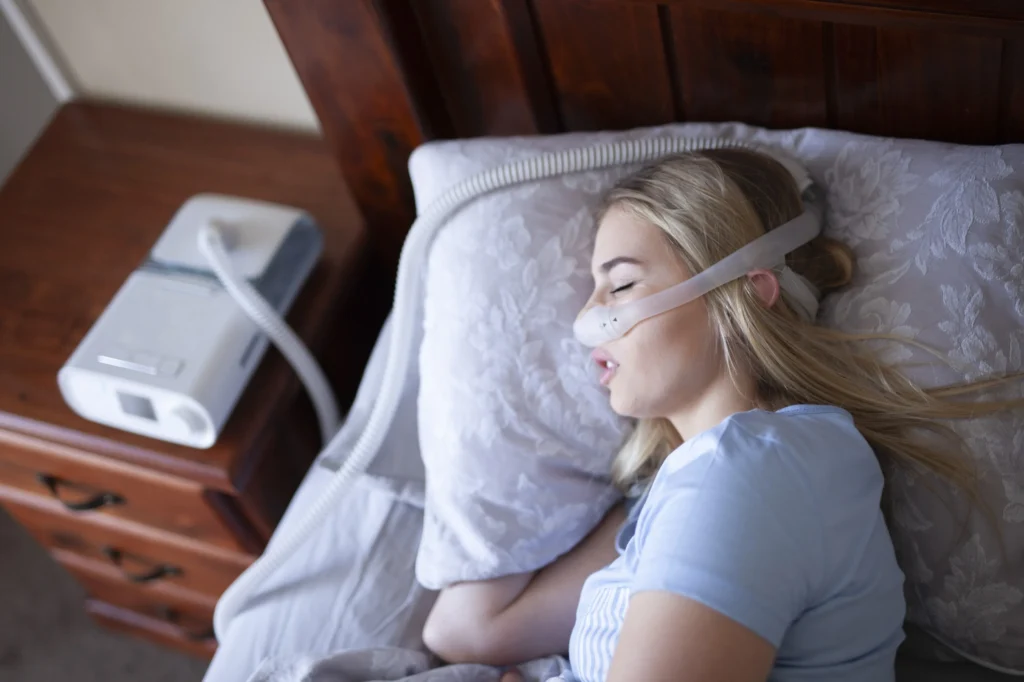Are you yawning all day even though you got several hours of sleep the night before? Do you wake up in the middle of the night to drink water due to dry mouth? Or does your partner wake you up because you are constantly snoring? If this is a familiar condition for you, you might want to consider sleep apnea.
What is Sleep Apnea?
Sleep apnea is a “potentially serious sleep disorder in which there is repeated cessation of breathing during sleep. According to Mayo-Clinic "If you snore loudly and feel tired even after a full night sleep, you may have sleep apnea”. However, snoring alone is not necessarily a sign of sleep apnea. What happens in sleep apnea is that you stop breathing during your sleep, either because your airway is blocked (obstructive sleep apnea) or because your brain doesn't control your breathing properly (central apnea). The resulting lack of oxygen triggers a survival reflex that wakes you up long enough to resume breathing. While this reflex keeps you alive, it disrupts your sleep cycle as a result you don't get quality sleep. Sleep Apnea Cleveland Clinic
Types of Sleep Apnea
- Obstructive Sleep Apnea: Obstructive sleep apnea is the most common form of sleep apnea and occurs when the upper airway becomes blocked because the muscles in the throat or pharynx relax and block the air flow to the lungs. Due to the decrease in oxygen in the blood, the sympathetic nervous system is activated and gives a wake-up call to prevent suffocation. Most of the times, this awakening happens unconsciously, however, because of this the phase of deep REM sleep is interrupted.
- Central Sleep Apnea: It is quite rare and is due to a disorder of the central nervous system. It happens when the brain does not send the right messages to the muscles that control breathing. However, central sleep apnea is usually associated with an underlying disease such as stroke or heart failure.
- Mixed Apnea: There is a third type of sleep apnea, which is a combination of the previous two. Patients with this type of apnea may initially appear to be suffering from obstructive sleep apnea, but over time, treating obstructive sleep apnea with a CPAP machine does not work. Then the appropriate treatment is using a BiPAP machine.
Symptoms That Show You May Be Suffering From Sleep Apnea
- Loud snoring that is often punctuated by panting and wakes up those around you.
- Sudden awakening due to a feeling of suffocation.
- You wake up in the morning with a sore throat and/or a very dry throat because your apnea causes you to breathe through your mouth.
- Sleepiness during the day.
- Morning headaches and loss of attention due to lack of sleep.
- Lack of energy even after a full night's sleep as breathing problems may wake you up unconsciously and you don't enter REM sleep.
- Gastroesophageal reflux during sleep or upon waking in the morning.
- Impairment of concentration and memory disturbances.
- Irritability and mood swings.
- Sexual dysfunction.
- Frequent urination at night.
Who Are Most Likely to Get Diagnosed with Sleep Apnea
It is proven that there are some key factors that can contribute to the occurrence of a sleep disorder, such as sleep apnea. Some of these are:
Obesity: People with a body mass index that exceeds normal are more likely to develop symptoms of sleep apnea. According to research, the rate of sleep apnea in people with obesity is 40%. "Fat deposits in the throat and around the tongue and palate make the airway much tighter and smaller," says sleep medicine expert Neeraj Kaplish, MD, director of the Sleep Labs and clinical associate professor of neurology at the University of Michigan in Ann Arbor.
Sex and Age: Although sleep apnea can occur at any age, even in young children, older people are more likely to develop sleep apnea. Men are also at greater risk than women, according to sleep expert Kaplish. "This may be related to fat distribution and hormones."
Anatomical Characteristics : Enlarged tonsils, adenoids, retrognathism or small jaw, and scoliosis of the nasal septum are some causes of sleep apnea.
History of Sleep Apnea: People who have a close family member with obstructive sleep apnea are at greater risk of developing it themselves.
Diabetes: A study found that people with type II diabetes were 48% more likely to develop sleep apnea than those without diabetes. Insulin resistance in diabetes may increase the risk for apnea, while inflammation from sleep apnea may increase the risk for diabetes. Thus a vicious circle is created.
Smoking: Smoking leads to inflammation in the upper airway, which can affect breathing as well as how well the brain communicates with the muscles that control breathing.
How Sleep Apnea Affects the Body
People suffering from sleep apnea suffer from fatigue, concentration problems and impaired memory. They often sleep during the day, while the structure and phases of sleep are not completed as they should be. The stage of deep sleep which is also the fourth stage REM (Rapid Eye Movement) relaxes all muscles except those that control the eyes, heart and breathing. Muscle paralysis has serious effects on sleep apnea sufferers as the airways become blocked and the patient is forced to revert to previous lighter stages of sleep. Failure to reach REM sleep has consequences not only for physical but also for mental health .
Anxiety, depression. Interrupting REM sleep and returning to lighter stages of sleep, leads to an increase in stress hormones and a decrease in mood is more likely to occur. Poor quality sleep weakens the system of neurotransmitters such as dopamine, the lack of which can lead to symptoms of depression and decreased memory and concentration.
High blood glucose levels. Research has shown that sleep apnea is linked to Type II Diabetes due to insulin resistance. People with type II diabetes and sleep apnea find it more difficult to manage diabetes treatment.
Low oxygen levels in the blood. Frequent interruptions of breathing during the night reduce oxygen levels in the blood. People suffering from asthma, sleep apnea aggravates their condition.
Hypertension and Cardiac Complications. According to researches that have been conducted, it has been shown that sleep apnea is associated with cardiac arrhythmias. This of course depends on the severity of the obstructive sleep apnea syndrome. The most common cardiac complication in people with obstructive sleep apnea is atrial fibrillation. Its main causes are blood pressure fluctuations and hypoxemia.
Cholesterol increase. According to University research results that were published in the journal Respirology, people with severe sleep apnea have an increased risk of higher total LDL cholesterol, elevated triglycerides and lower HDL cholesterol. The research was done on 8,592 Europeans and it should be noted that they did not have a previous diagnosis of high cholesterol and were not taking medication for it. The results of the research underline the importance of treating sleep apnea.
Suppression of the immune system. It is a general truth that quality and sufficient sleep, especially in children, contributes to the strengthening and protection of the immune system. During sleep, the immune system produces antibodies to fight various viruses and infections. Also, during sleep, growth hormone is produced, necessary for people who are still in the development stage, such as children.
Obesity. Obesity can be not only a result of sleep apnea but also a factor in the appearance of the syndrome. People who are overweight, who have a lot of fat in the neck are more likely to experience obstructive sleep apnea. Lack of sleep and fatigue leads to metabolic disorders, such as hunger, increased desire for food and especially fatty foods and sugar.
Treatment of Sleep Apnea
Initially, the diagnosis of sleep apnea should be made by your pulmonologist and after undergoing a sleep study, so that you can follow the appropriate treatment depending on the severity of the syndrome. The most effective and reliable non-invasive treatment for obstructive sleep apnea is the use of a Continuous Positive Airway Pressure (CPAP) machine. How does a CPAP machine work?

The CPAP device plugs into an outlet and is placed next to the bed where you sleep. A tube connects the machine to a mask that covers the nose or mouth, which you wear while you sleep. The CPAP machine pushes a steady stream of air through the nasal mask you wear. The airflow pushed by the CPAP machine helps keep your airway open so you snore less (or not at all) and sleep better.
Since CPAP therapy is usually quite effective for obstructive sleep apnea, its failure to relieve symptoms suggests that the patient may have central sleep apnea. In this case you can use a different type of airway pressure device such as a BiPAP device. A BiPAP machine works the same way as a CPAP machine, with the only difference being that it doesn't deliver the same, constant air pressure all the time. In contrast, the BiPAP device releases air at a higher pressure during sleep inhalation and a lower pressure during sleep exhalation. There is also a different type of airway pressure device that automatically adjusts the pressure while you sleep (auto-CPAP). Another option is oral appliances, designed to keep the throat open. However, CPAP therapy is more reliable than oral appliances. Other obstructive sleep apnea treatments your doctor may recommend are invasive.


